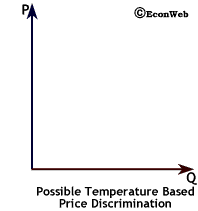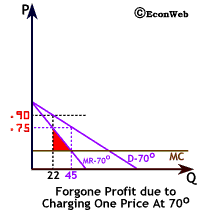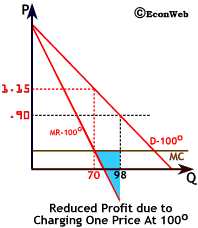
Whether Coke is considering such machines or not, they are certainly easily built with existing technology. In fact, current technology allows for a great many forms of price discrimination that would be new to consumers. The idea of basing soft drink sales price on temperature is only one of many such possibilities, but it's an easy one to examine.
As we know, a price discriminating firm attempts to identify consumers with different demands and charge them accordingly. As we point out elsewhere on the site, perfect price discrimination would require psychic abilities (or psychic vending machines) but fairly sophisticated price discrimination does not. Consumers would be "identified" for price discrimination purposes by the weather conditions prevailing at the time they arrive at the soda machine.

Consider the graph, shown to the right, illustrating possible demand curves and how a temperature sensing soda machine would, ideally for the vendor, set prices. The lower demand and marginal revenue curves apply when the average temperature is 70° Fahrenheit while the higher demand and marginal revenue curve are those for soft drinks when the temperature is 100° Fahrenheit. As shown here, demand for cold soft drinks increases considerably on very hot days, and probably becomes somewhat more inelastic. We make the fairly realistic assumption that the Marginal Cost (MC) of supplying soda is constant.
As we know, firms maximize profit by selling where Marginal Revenue = Marginal Cost. If the firm, or the vending machine software, can make a good guess as to the appropriate demand curves depending on the temperature, it could set profit maximizing prices accordingly. For the case shown to the right, the soda machine would maximize profits by charging 75¢ per soda when the temperature is 70° and charging $1.15 when the temperature is 100°.

The alternative to price discrimination is, as vending machines work now, to charge a single price no matter what the temperature. To the right we show how this causes the firm to lose profit compared to price discrimination. Let's suppose the firm chose 90¢ as its fixed price for soda, regardless of the weather. As we can see to the right, when the temperature is 70° this is too high a price relative to profit maximization. By selling only 22 sodas at 90¢ the firm forgoes the profit represented by the red triangle. This is because it does not sell 23 units (45 - 22) for which the marginal revenue is greater than the marginal cost.

To the left we show that, from the standpoint of profit maximization, 90¢ is too low a price when the temperature is 100°. The blue triangle represents losses from charging this lower price. The added units sold above 70 earn marginal revenue below their marginal cost so the firm's profit is reduced by the area shown.
Our Prediction: This news story was originally reported in most places as one about vending machines that raise prices in hot weather. This sounds unfair to most consumers and leaves competitors able to say, as Pepsi did, that they aren't going to raise prices on hot days. So competitive pressure and consumer reactions may keep such machines at bay for a while. However, it shouldn't take long for the marketing folks to figure out that the way to gain consumer acceptance is to install machines that lower prices on cold days or at low demand times but that don't raise prices above what was charged previously. Once consumers become acclimated to adjustable prices the "base" or "original" price becomes a meaningless concept. This is, for example, how most consumers have come to regard air fares.
As companies find more ways to gather, store, search and exchange data on consumers the price discrimination possibilities become quite sophisticated. For example, RealJukebox by Real Networks sends information back to Real Networks every time the program is run including: the number and format of songs on the computer, the favorite type of music of the user and a unique user code created when RealJukebox is registered. You can imagine such information being used by vendors to, perhaps at first, lower prices to users for music that is not their favorite type.
There are other possibilities that don't require any information be given by consumers. Vending machines could capture digital images of each customer along with information about what is purchased. Even if customers never supply any personal information it wouldn't be too difficult to build up a unique profile for each consumer matched to various aspects of a digital image. There is no technical reason this information couldn't be shared with other vending machines and used for various price discrimination purposes. Imagine you travel to a different city but when you arrive all the vending machines already 'recognize' you and your vending tastes and adjust prices for you accordingly, or perhaps play commercials designed to appeal to you (no reason vending machines can't have video display) as you pass by. Soft drink vending machines that update warehouses via wireless modems on their available stock are already in use in a few places in the U.S. It's easy to imagine more sophisticated data gathering, transmission and use being added in the near future.
We can be sure that profit maximizing firms will always be looking for new ways to increase revenue and cut costs. How much newer data-gathering, communications, and information retrieval technology is used to create sophisticated price discrimination mechanisms will depend on consumer acceptance and competitive or collusive behavior by other firms. Consumers have accepted certain types of price discrimination for decades: off-season hotel rates, cheaper fares for vacation flyers vs. business flyers, student and senior discounts, and store coupons. Price discrimination is, for good or ill, a part of the future at least as much as it has been a part of the past, and more sophisticated systems are probably inevitable.
Price discrimination is why students often pay lower prices for certain services, and why you can usually fly home for the holidays much more cheaply than business executives can visit the same city for a business meeting. If you are, or can appear to be, the type of consumer who doesn't want or need most products at all or at least in a hurry, price discrimination will tend to work in your favor. If, on the other hand, you are, or seem to be, the type of consumer who needs or just badly wants everything and wants it right away, price discrimination will enable firms to increase their profits at your expense.
Copyright © 1995-2003 OnLineTexts.com, Inc. - All Rights Reserved